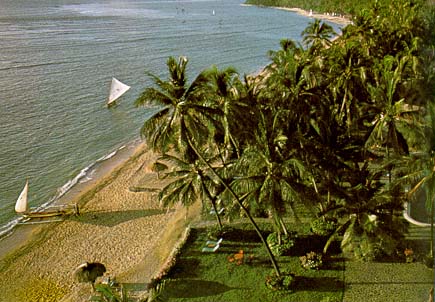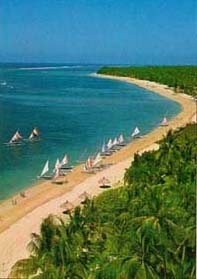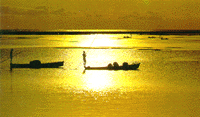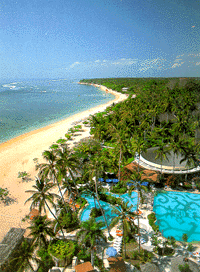
Sanur
|
|
Save for a
few scattered
villas owned by lords and heiresses, during the thirties Sanur beach
was left in seclusion. Pandy's Art Gallery was then an aquarium and
coffee shop. Tandjung Sari was a solitary temple on the cape, and Hotel
Bali Beach had not neared its conception. The only surviving home of
those times is that of the Belgian painter Le Mayeur, who moved to Bali
in 1932 and lived there for 26 years. The house, with its statued
gardens, luxuriant gold and crimson carvings, and Le Mayeur's own
paintings is now cared for by his widow, Ni Polok, once a renowned
Legong dancer and famed beauty-the ideal Balinese of his paintings. On
his death Le Mayeur willed the house to the Indonesian Government. A
guidebook is available. The house is situated close by the Hotel Bali
Beach.
|

|
|
By the
fifties, the
first cluster of bungalows was built as a small hotel. The villagers
were amazed that someone would want to settle by the ocean, as beaches
were traditionally shunned by the Balinese because of spirits. Yet
Sanur continued to attract an international elite and today is a
prominent luxury resort area in the Far East.
|
|
The Hotel
Bali Beach was
opened in 1966. While the Hotel Bali Beach expanded into a new wing and
bungalows (called the Bali Seaside Cottage), more than 30 hotels opened
their doors up and down the beach.
|

|

|
When the
Hotel Bali
Beach first opened, and even to this day, it was a source of wonder to
the Balinese. They came from all over the island to set eyes upon what,
to the modern world, were everyday matters, sky high rooms, running
water, electricity and elevators.
|
|
The Bali
Hyatt and Sanur
Beach are the next largest hotels. The building boom reached its peak
for a PATA Conference in 1974 when hotels at Sanur alone provided about
1,600 rooms. A new, open highway now links Sanur to Denpasar and Nusa
Dua. The volume of traffic to the Bukit Peninsula has increased since
more luxury hotels opened at Nusa Dua resort in 1982.
|
|
A wise
government
regulation that forbids buildings taller than a coconut palm has
allowed Sanur to retain much of its village character. The luxuriant
vegetation soon covers building scars, and moss transforms a new stone
wall. The regulation encouraged the growth of bungalow-style hotels
based on the style hotels based on the Balinese norm of many small
buildings within the one-house compound. The hotels of Sanur are all
comfortable and elegant. The bungalow-style hotels are popular with
tourists who enjoy the peace of garden settings.
|

|
|
Built
along the beach,
the hotels of Sanur are ideal in the early morning, for the coast there
faces the sun rising over Nusa Penida. On the clearest days, Lombok's
Rinjani volcano floats distantly above its collar of clouds, with
Bali's own Gunung Agung closer by. Elegant triangular sails of fishing
prahus glide on the calm sea. These boats are called jukungs and there
are many for hire for trips along the shore. At low tide, the waters
recede leaving great swathes of sand and coral that stretch for
hundreds of meters to the reef, It is then that villagers wander among
tide pools to collect coral, which they burn nearby to make building
lime. At night, fishermen wade by torchlight to catch shrimp and small
bait. Sanur is famous, too, for its magic, because of the many B
rahmana families that live there and its proximity to the sea. Its
farmers are reputed to grow the most delicious rice in Bali, formerly
reserved for the tables of kings.
|
|
It is easy
to spend a
day around Sanur: lazing by the pool-side, walking on the beach, or
following paths through the surrounding hamlets, rice fields and
coconut groves. You can take a look at the coral pyramid in the sea
temple or the old pillar inscription at Belanjong. In the evening the
choices are several. Relax on the beach (especially around the full
moon) or on the porch of a bungalow. Wander down to the beach market
and try the local food stalls. Watch a dance or drama (your hotel can
tell you when they are on) Or if it is action you are looking for,
there are night clubs at the three largest hotels.
|
Copyright
2001-2015, K&D Bali Designs. All rights reserved.
|